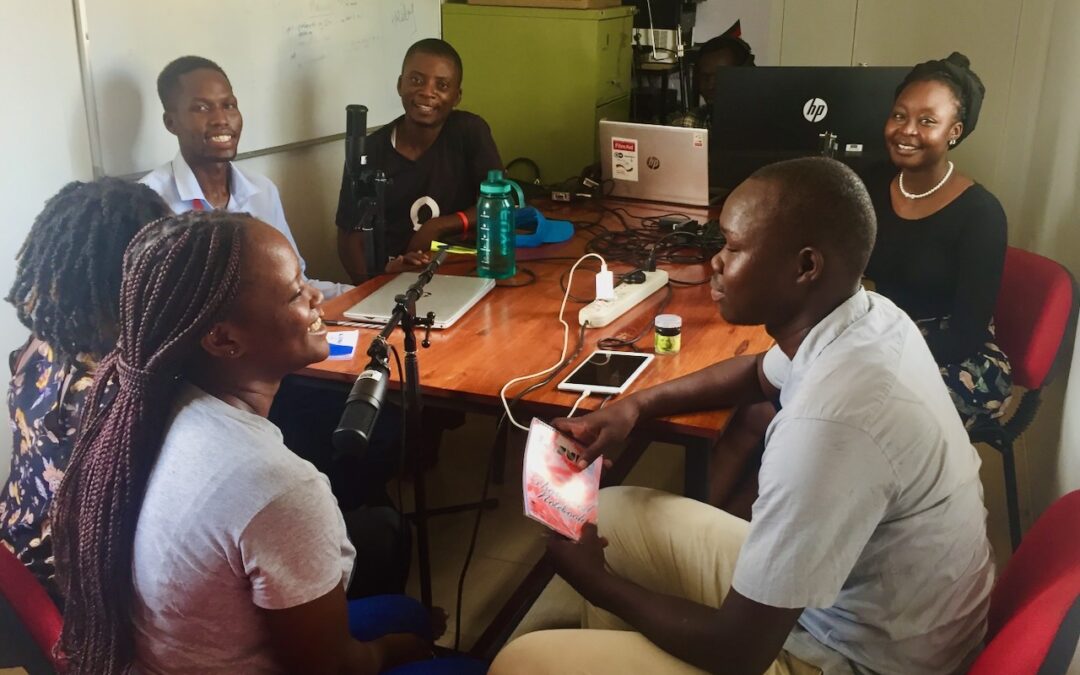By Dr Valentina Baú
Kakuma refugee camp is located in Turkana county, Northwestern region of Kenya. Established in 1992, it is home to approximately 200,000 refugees and asylum seekers from countries including Sudan, South Sudan, Somalia and the Democratic Republic of Congo. Other nationalities include Ethiopia, Rwanda, Uganda and Burundi.
A number of humanitarian agencies operate in the camp under the coordination of UNHCR. Despite the many challenges of life in Kakuma, the camp has an interesting media and communication landscape, and young people are able to participate in a number of engaging activities involving different platforms.
FilmAid Kenya is the agency responsible for the main communication-related activities and messages circulated to communities in the camp. It manages a series of creative projects that aim to both inform the youth on issues that affect them, and to develop their skills to connect and communicate using the media.
Through a Deutsche Welle (DW) funded project, the organisation runs what is called content generators. A training programme for young people delivered by DW facilitators provides the youth with news content production skills. The young producers are then able to create radio content on different thematic areas, addressing issues that are salient in the camp.
This is accompanied by the Sikika project, though which radio listening clubs are formed involving a range of young people from various zones in the camp. What is produced by the content generator process is distributed to listening groups’ heads, who have all received radio devices from FilmAid. The group heads coordinate and chair the listening sessions, bringing together approximately twenty people who listen to the radio content and provide their feedback and views about the issues discussed. These views are collected by each group head and reported back to FilmAid. This defines the course for the next topic that is going to be presented again on radio.
Young people are also targeted by the agency through the distribution of video content to health facilities. The latter are first provided with screens, which are typically set up in the waiting areas of a clinic. Videos conveying health-related messages relevant to the youth (and other groups) are then broadcast to reach the audience. An example is the Red Cross health centre in Kalobeyei, where a large screen is utilised to screen FilmAid video content that deals with health, hygiene and nutrition-related topics.
FilmAid Kenya also makes use of its Virtual Distribution Network (VDN). This consists of a number of Whatsapp groups (which include young people) that the agency connects with by sharing video content directly on the platform. Young people receive video content to watch on their phones. They are then invited to join a session with an expert who discusses the issues presented in the videos and gives the opportunity to people to ask questions. An example is the issue of school dropouts. FilmAid produced a full film on the topic, which was then trimmed into small portions that were shareable and viewable on Whatsapp. Young people were then able to watch the content and were invited to attend a session with a representative from the Ministry of Education, who spoke to the issues raised in the film.
An additional radio programme that FilmAid used in the past to target the youth is Sauti Youth Show. This show attracted the youth primarily through music played by a DJ. At the same time, an expert was brought in to discuss issues affecting the youth. These could range from unemployment to access to business opportunities, digital technology and even relationships. Sauti was a popular show among the youth, as it touched upon issues that were important to them.
While most of the other agencies operating in the camp make use of FilmAid to package and deliver important messages related to their respective mandates, some also implement their own media and communication initiatives. Peace Winds Japan, for example, used participatory theatre and dance to engage young people in discussing issues that affect them, such as teenage pregnancy. The agency would circulate a call both in schools and youth centres for interested people to participate in the activity. A group would then gather, and each person would be assigned a role: this could be that of an actor, in the case of a play, or that of a dancer, if the activity was dance-based. Everyone was given a chance to perform and the opportunity to reflect on the main topic through the use of art.
GIZ, the German Agency for international development, which is another important actor in the camp, has also engaged in a communication-focused initiative through the creation of a digital platform for the youth. This could be accessed online by young people and had the purpose of providing information on jobs and employment related opportunities. The platform was also designed so that users could submit questions or share feedback. The most interesting element of the site were the sound bites. These were short audio-based contents, modelled along the podcast example, which were produced by the youth themselves through the help of an external organisation. Thanks to these, young people were able to listen to the experience and advise from their peers on their job search.
GIZ has also produced comic books, particularly in relation to conflict among the youth (and beyond). The images were useful in providing an understanding around the issues that created conflict and in engaging with mediation.
Another unique initiative in the camp is Kakuma Got Talent. Implemented by the Lutheran World Federation in partnership with other agencies, this annual programme offers a broad range of activities for young camp residents that take place throughout the year. Participants get to showcase their talents in front of an audience, which include the Turkana local community. Finalists are then invited to travel to Nairobi for the final stage of the show. You can follow what is happening with the 2023 release of the show here.

